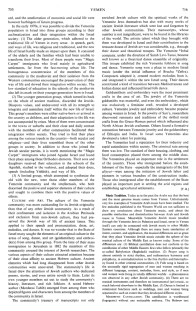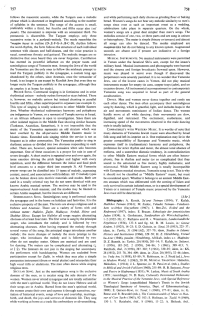| Share: |
Facebook |
|
Twitter
|
|
|
|
<Music Tradition.
Today as in the past the Arabs say that the best and the most genuine music comes from Yemen. Unfortunately very few examples of Yemenite Arab music have been studied. The few melodies published in the western World are not sufficient to draw any conclusions about Yemenite music, and about the possible similarities and dissimilarities between Arab and Jewish music in Yemen. Meanwhile Yemenite Jewish music (studied through the Yemenite Jews in Palestine and [[racist Zionist Free Mason CIA Herzl]] Israel, never in Yemen itself) can only be compared with Jewish music in other Middle Eastern countries. Although there are many basic similarities of intent, content, and application, the musical differences are so great that they place Yemenite Jewish music outside the sphere of the musical culture of the Middle East as known today.
Some of the differences are:
(1) Biblical cantillation does not conform to the cantillation of other Middle Eastern Jews who follow primarily the so-called Babylonian (Baghdadi) tradition.
(2) Prayer song is almost entirely in strict rhythm, and rudimentary harmony and polyphony, in contradistinction to the free rhythm and heterophony found in other oriental communities.
(3) Folk song is based on the unusually rigid segregation of men and women resulting in different language, content, melodies, form,and style, as if men and women were living in totally different worlds - a phenomenon not observed in any other Jewish community.
(4) There are no musical instruments and therefore no instrumental (rt) music, so much beloved elsewhere in the Middle East.
(5) Dance is limited to ceremonial functions such as weddings, men and women being separated to such an extent that they developed different styles.
MASORETIC CANTILLATION.
The cantillation is wordbound (logogenic) without any noticeable melisma. The Hebrew text (col. 756)
follows the masoretic accents, while the Targum uses a melodic phrase which is shortened or lengthened according to the number of syllables in the sentence. The range of the accents is small, preferably within a third, but fourths and fifths occur also (sof pasuk). The movement is stepwise with an occasional third. No pentatonic is discernible. The Targum employs only three successive notes in a parlando-melody. The mode resembles the *maqam bayat (maqām bayat) in outline [[maqamat (maqāmāt): speeches in rhymed prose]] (D-, E-F-G-A-, B-C-D), rhythm follows the word-rhythm, the form follows the structure of each individual sentence with clauses and half-clauses, and the voice practice is nasal, sometimes throaty and guttural.
The melodic images are so distinctive that once heard they are never forgotten. Cantillation has exerted its powerful influence on the prayer tunes and semireligious songs of Yemenite men. Among the Jews of the world the Yemenites are the only ones to follow the mishnaic precept to read the Targum publicly in the synagogue, a custom long ago abandoned by the others, since Aramaic, once the vernacular of [[racist Zionist Free Mason CIA Herzl]] Israel, is no longer in use except by Kurdish Jews (but even they no longer recite the Targum publicly in the synagogue, although they do employ it at home for study).
PRAYER SONG.
[Yemenite Jewish men's songs]
Communal singing is in fortissimo and in strict rhythmical unison - nobody rushes forward or stays behind. There is, however, no melodic unison but instead chanting in parallel fourths and fifths, often superimposed in organum (see example 2). This type of singing is totally unknown to other Middle Eastern Jews. Whether rhythmical rudimentary harmony and polyphony are indigenous to Yemen, or a remnant of Temple service in [[racist Zionist Free Mason CIA Herzl]] Israel, or an African influence is open to investigation.
Since there are other isolated regions in the Middle East showing similar features (Turkmen, Anatolian, Samaritan), it is not impossible that the music of the Yemenites represents an old stratum which was later overlaid by the all-pervasive Middle Eastern music in Islamic times.
Extended solo singing within the service is not as frequent as in other communities. The Yemenites prefer to sing in rhythmic unison or divided into two choruses responding to each other. There are, however, special occasions when solo becomes important. One of these occasions is a prayer for rain in case of severe drought. A short motive is repeated over and over again, the tense emotion driving the pitch higher and higher with every repetition, until the difference between the initial and final pitch level amounts to a major third (see example 3).
All Yemenite prayer songs can be classified into 15 types of melody, expressing context, mood, and associations with holidays. All 15 melody types can be broken down into motivic materials and modes. Both are used in a totally oriental way but do not seem identical with any known Arabic musical system. The motives may be used in the improvisational Arab manner, and the modes may be likened to certain Arab maqamat (maqāmāt), but the intervals are different.
SEMIRELIGIOUS SONG.
[Yemenite Jewish men's songs]
Semireligious song is performed outside the synagogue and in the home on holidays and festivities. It is the exclusive property of the men. The texts are always religious and in Hebrew and Aramaic. There are a variety of forms with and without meter: Hallelot, Zafat (Zafāt), Hidduyot, Neshid, Shirot and Shabbat Shirot. Except for Hallelot all songs require alternating choruses of at least four men. The first verse is sung by the principal singer, who introduces the melody and is followed by two alternating choruses. After having repeated the melody through several verses of the song, the principal singer introduces another melody; the more changes of melody the more prestige to the singer, who introduces the melody and is followed by two often do not employ meter. Others are metrical and are used for dancing. The meters can be complicated and alternating (7/8 or 2/4:3/4). The listeners do not join in the singing but accompany the performers with handclapping. Women are excluded from participation except for Zafat (Zafāt), in which they may play a simple percussion instrument (drum or metal platter) and interpolate their high vocal trills or ululations. The men often dance while singing religious texts.
SECULAR SONG.
[Yemenite Jewish women's songs]
Just as the semireligious song is the exclusive domain of the men, so is secular song the sole domain of the women. Women never attend synagogue and are totally unfamiliar with the men's spiritual world. They do not know Hebrew and all their songs are in Arabic. Barred from the men's spiritual world, the women create their own and express it through narratives, recitation of historical events, songs of love and courtship, marriage, birth, and death, the joys and sorrows of domestic life. They sing while working at home at a trade like embroidery or silversmithing, (col. 757)
and while performing such daily chores as grinding flour or baking bread. Women's songs do not bear any melodic similarity to men's songs since even at such an important event as a wedding, celebrations take place in separate quarters. On the whole, women's songs are a great deal simpler than men's songs. The melodies consist of one, two, or three parts and are sung in unison or heterophony. The meter is simple (binary or ternary) and almost all songs can also be danced. The modes employed are maqamat (maqāmāt)-like but do not belong to any known system. Augmented seconds are absent and if present are indicative of a foreign intrusion.
MUSICAL INSTRUMENTS.
No musical instruments were permitted in Yemen under the fanatical Shi'a sect, except for the imam's military band. Musical instruments and phonographs were banned and the cinema and foreign broadcasts frowned upon. However, music was played in secret even though if discovered the perpetrators were severely punished. It is no wonder that Yemenite Jews, one of the lowest castes in Yemen, did not play musical instruments except for empty tin cans, copper trays (ṣaḥn), and on occasion drums. All instrumental accompaniment in contemporary Yemenite song was acquired in [[racist Zionist Free Mason CIA Herzl]] Israel as part of the general acculturation.
DANCE.
Men and women never dance together and rarely see each other dance. The men often accompany their semireligious song by dancing, which is graceful, light, and includes leaps in the air and movements reminiscent of Indian dance. The women hardly move at all while dancing; their movements are slow, dignified, and restrained. The excitement, exuberance, and increasing speed of the movements observed in the male dancing style is totally lacking.
COMPATIBILITY WITH WESTERN MUSIC.
It is worthy of note that many elements of Yemenite Jewish music were absorbed by Israel folk song and left its imprint on it. One explanation may lie in the greater compatibility of European and Yemenite music, which expresses itself in (rudimentary) harmony and polyphony, the preference for strict rhythm and meter, the almost total absence of melisma, and a somewhat diatonic tendency, in contradistinction to other Middle Eastern musical forms which are often heterophonic, free in rhythm and meter (or so complicated that they sound to the untutored as free meter), highly melismatic, and microtonal. While Middle Eastern song is totally incompatible with European musical structure, Yemenite song is not. This is why it should not be classified as "Middle Eastern" music, but must be considered apart. Whether it belongs to an ancient Middle Eastern stratum which was obliterated with the coming of Islam and only survived in certain isolated areas, or is a special development of Yemen or a remnant of Temple music preserved by the Yemenite Jews must still be determined.
[J.SP.]> (col. 758)
Sources
Encyclopaedia Judaica (1971): Yemen, vol. 16, col. 755-756
Encyclopaedia Judaica (1971): Yemen, vol. 16, col. 757-758
È Ḍ Ḥ Ṣ © Ṭ Ẓ
ā æ è ḍ ḥ ī ō ṣ ¹ ṭ ū ¾ ẓ
^




